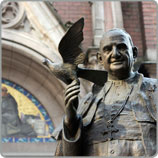The Second Vatican Council Lesson Plan

Enjoy this lesson about the Second Vatican Council, from Finding God, Grade 8. © Loyola Press.
Download a PDF of the student pages.
Learning Outcomes
The students will be able to
- identify the issues addressed during the Second Vatican Council.
- define laity and synod.
Key Terms
synod—a meeting of bishops from all over the world to discuss doctrinal or pastoral matters. Synods offer suggestions to the pope, which may or may not become official teachings at a later time.
laity—those who have been made members of Christ in Baptism and who participate in the priestly, prophetic, and kingly functions of Christ in his mission to the whole world. The laity is distinct from the clergy, whose members are set apart as ordained ministers to serve the Church.
Materials
- Copies of documents from the Second Vatican Council
Before You Begin
Before the session, prepare to show a Web clip of the Second Vatican Council opening. Prepare for display copies of documents promulgated during the Second Vatican Council.
1. Begin
Share a story about a time you had to adjust to change, such as moving to a new city or beginning a new job. Then invite young people to share their own stories. Ask: What helped you adjust to the change you encountered? (Possible answer: the support of family and friends) How can you support people who are experiencing change in their own lives? (Possible answers: treat them with kindness, offer words of welcome and support) Say: In this article we are going to read about how during the middle of the last century, the Church responded to cultural changes that were happening.
2. Connect
Invite a volunteer to read aloud the article title and the first paragraph. Say: Fascism is an ideology that values the nation above the individual. Communism is a philosophy in which goods are held in common. Ask: What events changed the world during the 1900s? (Possible answers: the Industrial Revolution, world wars, the atomic bomb, advances in technology)
Ask: Why do some people like old shoes? (Possible answer: They are comfortable.) Why is it necessary to get new shoes? (Possible answer: The old ones don’t fit.) Say: Pope John XXIII realized that the Church needed to try new approaches to connect with the modern world. To many, the old ways were more comfortable. But the pope knew that for the Church to continue serving people, change was necessary.
Sacred Art
Read aloud the feature titled Sacred Art. Explain that the pope is the figure in white and that all the men in red hats are cardinals. Ask: Why do you think the painter chose to place the cross in a prominent position? (Possible answer: to remind Church leaders that they are responsible for leading the Church founded by Christ)
Invite volunteers to read aloud the section Providing Direction for the Future. Ask: If you asked your family to choose a restaurant for dinner, would everyone agree? (probably not) Remind young people that bishops are responsible for the spiritual needs of the people in their dioceses. Point out that people living in different parts of the world can have drastically different needs. Say: One of the challenges the bishops faced during the council was addressing the needs of the people they served. Then explain that a word Pope John XXIII often used when referring to the council is aggiornamento, a Latin word that means “to bring up to date.” Say: This spirit of the word aggiornamento set the tone for the rest of the council. If possible, show a Web clip of the council opening.
Invite a volunteer to read aloud the section Renewal. If possible, display copies of the documents promulgated during the Second Vatican Council. Read aloud the titles of the documents to help young people understand the breadth of issues discussed by Church leaders. Explain that the laity, or lay people, are baptized individuals who participate in the mission of Christ but who are not ordained clergy.
Our Catholic Character
Read aloud the feature titled Our Catholic Character. Ask: Why did the changes that were approved during the Second Vatican Council help people enter into the celebration of the Mass? (Possible answers: People were able to pray more actively. People were able to participate in the Mass in their own language.)
3. Close
Say: The Mass is a gift. Let’s thank Christ for entrusting us with this gift. Invite a volunteer to pray aloud a brief prayer thanking Jesus for the gift of the Mass.
Take It Home: Real Presence
Point out that the Mass calls for our full participation. Ask: How can we participate fully? (Possible answers: sing, think about the words we pray) Explain that the Mass is the source and summit of our lives as Catholics. Say: The Mass is the summit of our lives because it is our highest prayer of praise to God for the gift of Jesus in the Eucharist. The Mass is the source of our lives because it provides all that we need. Explain that the Mass is also a model for how we are to live—in thanksgiving for all that God has given to us.
Encourage young people to practice awareness of the world around them. Say: We often fail to notice what is really going on around us. For example, when I am a passenger in a car and traveling a route I often drive, I notice many things I don’t see when I’m driving. Have young people write what they notice as they practice a sense of awareness over the next week. Ask young people to share what they discovered by writing it in a journal. Encourage them to explore the difference between seeing and observing. Explain that God wants us to observe and participate in life rather than merely watch it pass us by.

